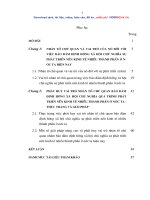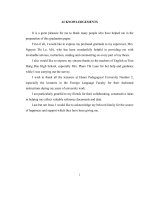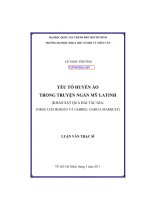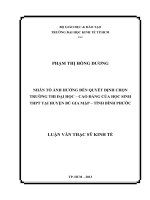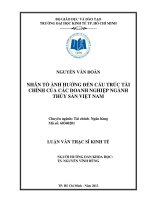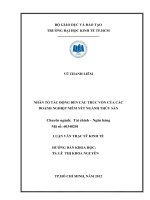(Luận văn thạc sĩ) strategies to correct common errors in pronouncing english final consonant clusters made by second year english majored students at phuong dong university
Bạn đang xem bản rút gọn của tài liệu. Xem và tải ngay bản đầy đủ của tài liệu tại đây (1.51 MB, 76 trang )
VIETNAM NATIONAL UNIVERSITY, HANOI
UNIVERSITY OF LANGUAGES AND INTERNATIONAL STUDIES
FACULTY OF POST-GRADUATE STUDIES
------oo0oo------
NGUYỄN THỊ HẢI
STRATEGIES TO CORRECT COMMON ERRORS IN
PRONOUNCING ENGLISH FINAL CONSONANT CLUSTERS
MADE BY SECOND-YEAR ENGLISH-MAJORED STUDENTS
AT PHUONG DONG UNIVERSITY
(NHỮNG CHIẾN LƯỢC SỬA CÁC LỖI THƯỜNG GẶP KHI PHÁT
ÂM NHÓM PHỤ ÂM CUỐI TRONG TIẾNG ANH CỦA SINH VIÊN
NĂM THỨ HAI CHUYÊN TIẾNG ANH TRƯỜNG ĐẠI HỌC
PHƯƠNG ĐÔNG)
M.A. Minor Programme Thesis
Field: English Language Teaching Methodology
Code: 60 14 10
Hanoi – 2011
VIETNAM NATIONAL UNIVERSITY, HANOI
UNIVERSITY OF LANGUAGES AND INTERNATIONAL STUDIES
FACULTY OF POST-GRADUATE STUDIES
------oo0oo-----NGUYỄN THỊ HẢI
STRATEGIES TO CORRECT COMMON ERRORS IN
PRONOUNCING ENGLISH FINAL CONSONANT CLUSTERS
MADE BY SECOND-YEAR ENGLISH-MAJORED STUDENTS
AT PHUONG DONG UNIVERSITY
(NHỮNG CHIẾN LƯỢC SỬA CÁC LỖI THƯỜNG GẶP KHI PHÁT
ÂM NHÓM PHỤ ÂM CUỐI TRONG TIẾNG ANH CỦA SINH VIÊN
NĂM THỨ HAI CHUYÊN TIẾNG ANH TRƯỜNG ĐẠI HỌC
PHƯƠNG ĐÔNG)
M.A. Minor Programme Thesis
Field: English Language Teaching Methodology
Code: 60 14 10
Supervisor: Nguyễn Hoàng Lan, M. A
Hanoi - 2011
iv
TABLE OF CONTENTS
CANDIDATE’S STATEMENT ................................................................................ i
ACKNOWLEDGEMENT......................................................................................... ii
ABSTRACT ............................................................................................................... iii
TABLE OF CONTENTS .......................................................................................... iv
LIST OF TABLES, CHARTS................................................................................... vii
PART 1: INTRODUCTION .................................................................................... 1
1. Rationale of the study ...................................................................................... 1
2. Aims of the study ............................................................................................ 2
3. Scope of the study ........................................................................................... 2
4. Method of the study ......................................................................................... 3
5. Thesis Design .................................................................................................. 3
PART 2: DEVELOPMENT ...................................................................................... 5
CHAPTER 1: LITERATURE REVIEW ................................................................. 5
1.1. English pronunciation ..................................................................................... 5
1.1.1. Standard English Pronunciation .............................................................. 5
1.1.2. Aspects of English pronunciation ........................................................... 5
1.1.2.1. Consonant sounds ....................................................................... 6
1.1.2.2. English final consonants and consonant clusters ......................... 7
1.1.2.3. A comparison between English and Vietnamese final consonants.9
1.2. Errors.............................................................................................................. 12
1.2.1. Errors vs. Mistakes ................................................................................. 12
1.2.2. Pronunciation errors ............................................................................... 13
1.2.3. Final consonant clusters errors ............................................................... 13
v
1.3. Error correction............................................................................................... 14
1.3.1. Definition and types of error correction .................................................. 14
1.3.2. Approaches to error correction ............................................................... 16
1.4. Techniques to deal with final clusters .............................................................. 16
CHAPTER
2:
AN
OVERVIEW
OF
TEACHING
AND
LEARNING
PRONUNCIATION AT PDU ................................................................................... 21
2.1. The syllabus .................................................................................................... 21
2.2. The learners .................................................................................................... 22
2.3. The teachers ................................................................................................... 22
2.4. The teaching and learning conditions .............................................................. 22
CHAPTER 3: METHODOLOGY ............................................................................ 24
3.1. Research questions .......................................................................................... 24
3.2. Subjects of the study ....................................................................................... 24
3.3. Data collection procedure ............................................................................... 24
3.4. Data analysis procedure .................................................................................. 25
CHAPTER 4: FINDINGS AND DISCUSSIONS ..................................................... 26
4.1. Findings from recordings and discussions ....................................................... 26
4.1.1. Overview of the errors with final clusters of 2nd year English-majored
students at PDU ............................................................................................... 26
4.1.2. Details of the errors with final clusters of 2 nd year English-majored
students at PDU ............................................................................................... 27
4.1.2.1. Reduction ................................................................................... 27
4.1.2.2. Substitution ................................................................................ 30
vi
4.2. Findings from observation and discussions ..................................................... 31
4.3. Comparison of the two findings ...................................................................... 33
4.4. Strategies to correct final clusters errors .......................................................... 33
PART 3: CONCLUSION ......................................................................................... 38
1. Summary of major findings.............................................................................. 38
2. Limitations and suggestions for further study ................................................... 38
REFERENCES .......................................................................................................... 40
APPENDIX 1: Checklist for recording .................................................................... I
APPENDIX 2: Findings from recordings ................................................................. II
APPENDIX 3: Checklist for observation ................................................................. XIX
APPENDIX 4: Findings from observation ............................................................... XXVI
vii
LIST OF TABLES
Table 1: Table of consonant sounds
pp. 6-7
Table 2: Component of consonant clusters
pp. 8-9
Table 3: Reduction errors found in the data from recordings
pp. 27-28
Table 4: Substitution errors found in the data from recordings
p. 30
Table 5: Errors from students’ reading out loud the 230 errors from recordings
p. 31
Table 6: Details of errors from observation
p. 32
LIST OF CHARTS
Chart 1: Types of errors
p. 26
Chart 2: Comparison of two results from recordings and observation
p. 33
1
PART 1: INTRODUCTION
1. Rationale of the study
English has become an important demand for schooling and job opportunities in the past
few years; however, many Vietnamese speakers do not have intelligible English
pronunciation so as to be easily understood in direct communication with foreigners.
Learners with serious pronunciation errors will certainly fail in communication. Therefore,
it is very essential to research learners‟ pronunciation errors, and then to seek out suitable
strategies to solve the problems.
Among many pronunciation errors that learners of English as a second language are likely
to make (i.e. intonation, stress, ending sounds, etc.), errors with final consonant clusters
can be considered serious because “learners‟ inability to produce final consonant clusters
can lead to incomprehensibility” (Avery & Erhlich, 1992, p.55). In the same line, CelceMurcia, Brinton & Goodwin (1996) supported that inaccurate pronunciation of consonant
clusters can make English language learners‟ speech difficult for native speakers to
understand, particularly in cases where the learners use epenthesis to break up clusters or
omit a consonant in a cluster (as cited in Arnold, 2009).
Serious as it might be, problems with final clusters can be considered as one typical
pronunciation error of Vietnamese learners. According to an earlier research by the
Australian Government publication Asian Language Motes (1978; as cited in Pham, 2009),
“initial clusters do not cause many problems, but final clusters are found extremely hard
for Vietnamese students”. Also in an article about common challenges faced by
Vietnamese learners, Deshayes (2005, p.6) firmly stated that “English consonant clusters
give Vietnamese learners problems not only because they do not have these consonant
combinations in their own language, but also because they produce a variety of syllable
types”.
2
Although final clusters errors are very common to Vietnamese learners, it seems that
teachers do not pay much attention to them. Firstly, it is perhaps because the final sounds
are not pronounced as clearly as other sounds in an utterance so they are less noticed by
both learners and teachers. In addition, few researches have been carried out on these
particular final clusters errors. The latest and most noticeable research on this issue was
done by Pham (2009); however, it did not analyze deeply students‟ final clusters errors as
well as did not suggest particular strategies for correcting them.
Being an English teacher at Phuong Dong University (PDU), I realize that many of my
students encounter difficulty in pronouncing English final clusters though they are able to
produce single consonants accurately. For the above reasons, I would like to conduct this
research entitled “Strategies to correct errors in pronouncing English final clusters
made by second- year English-majored students at PDU”.
The research hopes to find answers to the following questions:
What are the English final cluster errors that second-year English-majored students at
PDU often make?
What are some strategies to correct those errors?
2. Aims of the study
The main aim of the study is to analyze final clusters errors in pronunciation of the secondyear students in English Department, PDU, and then to suggest strategies to help teachers
deal with students‟ final clusters problems.
3. Scope of the study
There are many pronunciation errors that Vietnamese students are likely to make.
However, within the limit of a minor thesis, this study focuses on analyzing the students‟
final clusters errors and proposing the strategies for correcting them.
3
This study was implemented for a group of 30 English-major second-year students at
Phuong Dong University who are working with the course book “Let‟s talk 2” by Leo
Jones (2002).
4. Method of the study
30 English-majored second-year students from class 509701A2 were chosen to participate
in this study. Recording and observation were two methods used to collect data. The data
analysis procedure included two steps. In the first stage, all the speeches that the students
presented in their mid-term oral test were recorded and used for take-home analysis. Next,
all the errors made by students were counted in terms of types, sounds frequency and
seriousness in order to find out a list of common pronunciation errors students make with
final clusters. At the same time, tapes recorded from students were sent to a group of three
English teachers to help analyze and find errors and error frequency. After that, the data
were converted into tables and charts. In the second stage, the results from recording
analysis were used to design a checklist for observation process when each student was
asked to read the words individually. The results collected from observation were then
compared with the results from recording analysis to prepare for the next stage where
suitable solutions to students‟ pronunciation errors with final clusters were suggested.
5. Thesis Design
This thesis consists of three parts, namely Introduction, Development and Conclusion.
Part 1, the Introduction, presents the rationale, the aims, the scope and the method of the
study.
Part 2 is the development with four chapters. Chapter 1 (Literature review) introduces
some key concepts necessary for understanding this research including Standard English
Pronunciation, English final consonants & consonant clusters, Vietnamese final
consonants, Errors vs. mistakes, Pronunciation errors and Error correction. Also, it reviews
some previous studies related to the topic. Chapter 2 (Setting) gives an overview of
4
English pronunciation teaching and learning context at PDU. Chapter 3 (Methodology)
demonstrates a clear and detailed plan to collect adequate and reliable data for analysis
including the selection of subjects, research instruments, procedures of data collection as
well as procedures of data analysis. Chapter 4 (Results and Discussions) mainly deals with
the findings from the recordings and observation. Some discussions about these findings
can also be found in this chapter.
Part 3, the Conclusion, discusses the major findings and limitations of the research as well
as provides suggestions for further study.
5
PART 2: DEVELOPMENT
CHAPTER 1: LITERATURE REVIEW
In this chapter, the author provides readers with the relevant literature of the study by
introducing some key concepts necessary for understanding this research, as well as the
review of previous studies related to the topic. Some crucial concepts chosen to be clarified in
this part include Standard English Pronunciation, English final consonants & consonant
clusters, Vietnamese final consonants, Errors vs. mistakes, Pronunciation errors and Error
correction.
1.1. English pronunciation
1.1.1. Standard English Pronunciation
First of all, it is essential to define Standard English Pronunciation. Standard English is
defined as “a particular dialect of English, being the only non-localized dialect of global
currency without significant variation, universally accepted as the appropriate educational
target in teaching English; which may be spoken with an unrestricted choice of accent”
(Strevens, 1983, p.88, as cited in McKay, 2002, p.51). Therefore, Standard English
pronunciation can be any dialect of English that is widely used and accepted in the world.
It is common knowledge that there are two major dialects of English for international
broadcasts and in social and business settings: Received Pronunciation (RP) in the United
Kingdom and General American (GA) English in the United States. Vietnamese people tend to
follow RP English in which the /r/ sound is not pronounced at the end of words, so RP English
will be used as the criteria for analyzing students‟ pronunciation in this research.
1.1.2. Aspects of English pronunciation
Pronunciation is a complicated concept that involves many aspects. Generally, it can be
broken into the following components: vowels, consonants, word stress, rhythm, intonation,
and other aspects of connected speech (assimilation, elision, linking and intrusion). Basically,
6
the English sound system is studied under two main headings: segmental and suprasegmental.
According to Seferoglu (2005, p.304, as cited in Abuseileek, 2007, p.4), “Segmental aspects of
the sound system includes individual vowels and consonants, and the suprasegmental aspect
comprises words, phrases, and sentence stress, pitch contour or intonation, and rhythm”.
1.1.2.1. Consonant sounds
According to Peter Roach (2000, p.19), consonants are “sounds in which there is obstruction
to the flow of air as it passes from the larynx to the lips”. Specifically, consonant sounds are
the sounds in the production of which two articulators come close together so that air stream is
obstructed and can not get out freely.
Consonants can be described in terms of the manner of articulation, the place of articulation
and voicing. Kelly (2000) and Roach (2000) categorized the 24 consonants into 6 groups:
Plosive
Nasal
Fricative
Lateral
Affricative
Approximant
The following is the table of consonant sounds:
Bilabial
Labio-
Dental
Alveolar Palato-
dental
Plosive
Palatal
Velar
alveolar
+b
+d
+g
-p
-t
-k
Fricative
+v
+ð
+z
+ʒ
-f
-θ
-s
-ʃ
Affricative
-h
+ dʒ
- tʃ
Nasal
+m
Glottal
+ n
+ŋ
7
Lateral
+l
Approximant + w
+r
+j
Table 1: Table of consonant sounds
A stop cuts off airflow through either the mouth or the nose so there are oral and nasal stops.
Oral stops are often called plosives: /b, p, d, t, g, k/. Nasal stops are usually called nasals: /m,
n, ŋ/. English fricatives include /f, v, θ, ð, s, z, ʃ , ʒ , h/. English approximants include /j, w, r/,
and lateral /l/. Affricates can be seen as a sequence of a stop and a fricative which have the
same or similar places of articulation, and there are only two affricative sounds in English /tʃ ,
dʒ /.
1.1.2.2. English final consonants and consonant clusters
Any consonant except h, r, w and j may be a final consonant. Final consonant sounds in
English are listed as below:
/p/ - ship, tip
/s/
- miss, chess
/b/ - curb, rib
/z/
- his, was
/t/
/ʃ /
- wash, crash
/d/ - ride, side
/ʒ /
- garage, beige
/k/ - back, cook
/tʃ /
- church, catch
/g/ - bag, pig
/dʒ / - large, age
/θ/ - teeth, earth
/m/
- team, room
/ð/ - breath, clothe
/n/
- than, man
/f/
- beef, chief
/ŋ/
- thing, sing
/v/ - cave, give
/l/
- smile, feel
- eat, sit
When there are two or more consonants at the end of the word (called final cluster), the terms
“pre-final” and “post-final” consonants are used.
Pre- final includes: /m, n, ŋ, l, s/
8
Post-final includes: /s, z, t, d, θ/
Two consonant clusters:
o Pre-final followed by a final consonant
o Consonant plus post-final
E.g.: think, important, help, health, cats, etc.
Three consonant clusters:
o Pre-final plus final plus post-final (e.g. helped, twelfth, banks, etc.)
o Final plus post-final plus post-final (e.g. text, fifths, lapsed, etc.)
Four consonant clusters:
o Most are pre-final plus final plus post-final plus post-final.
e.g. prompts, twelfths
o Occasionally, there is one final and three post-final consonants.
e.g. sixths, texts
The table below presents the consonant clusters, extracted from Pham (2009):
Pre-consonant
Stops,
Post-consonant(s)
fricatives &
Liquids
Nasals
s
Max. 1 of
/l/
/m/
+
+
/n/
1 of
/ŋ/
/s/
+
+
+
affricates
Max. 3 of
/t/
/p/
+
/b/
+
+
+
+
+
+
+
/s/
+
/t/
/k/
/f/
/θ/
+
+
/d/
+
/z/
+
+
+
+
/g/
+
/d/
+
+
+
+
+
+
+
9
+
/v/
+
/θ/
+
/ð/
+
+
+
+
+
+
+
/s/
+
/z/
+
/ʃ /
+
/ʒ /
+
/tʃ /
+
/dʒ /
+
+
+
+
+
Table 2: Component of consonant clusters
1.1.2.3. A comparison between English and Vietnamese final consonants
English consonants are different from Vietnamese ones because “there are only six consonants
and two semi-vowels which can stand in word-final position” in Vietnamese (Nguyen, 2007,
p.4). Details about Vietnamese final consonants are adopted from Doan (1999, as cited in
Nguyen, 2007, pp.4-7) as follows:
i)
/m/ in words like
em [ɛ m] (I, younger sister/brother)
lượm [lɯ ɤ ːm] (pick up)
nghiêm [ŋiem] (strict)
ii)
/n/ in words like
ăn [an] (eat)
làm [laːm] (do)
phiên [fien]
iii)
/ŋ/: there are three allophones of this phoneme:
[ŋ͡ m]: bilabialized, proceded by rounded vowels /u, o, ɔ /
xong [soŋ͡ m]
10
súng [ʃ uŋ͡ m]
không [xoŋ͡ m]
[ɲ ]ːcorresponding to letters „nh‟, proceded by front vowels /i, e, ɛ /
bệnh [beɲ ]
tình [tiɲ ]
nhanh [ɲ ɑ ɲ ]
[ŋ]ːelsewhere
tặng [taŋ]
thiêng [tʰ ieŋ]
chuộng [cuoŋ]
iv) /p/ː with no air released after pronunciation, in words like
úp [up]
Pháp [fɑ p]
tiếp [tiep]
v) /t/ː In English, [t] ending is pronounced both as [t] and [ʔ ], but in Vietnamese it is
always pronounced shortly and sharply without aspiration such asː
ớt [ɤ ːt]
giết [ziet]
ghét [ɡ ɛ t]
vi) /k/ː this sound is produced where the letter “c”, “ch” is shown at the final position
of a syllable and it is agreed by many linguistics that this phoneme has 3 allophones
which appear in a complementary distribution.
[k͡ p]ː this ending sound is bilabialized if the consonant is preceded by
rounded vowels /u, ɒ , ɔ /
ngọc [ŋɔ k͡ p]
cốc [k͡ p]
nhục [k͡ p]
[c]ː preceded by front vowels /i, e, ɛ /, performed by letters “ch”
nghịch [ŋic]
11
lệch [lec]
sách [saːc]
[k]ː elsewhere
nhác [ŋaːk]]
bực [bɯ k]
luộc [luok]
vii) /w/: this final semi-vowel only appears in forms of letters “u” or “o” which follow
vowels to make diphthongs or triphthongs, for example:
đau [daːw]
vào [vaːw]
đều [dew]
viii) /j/: appears in forms of “i” or “y” and is preceded by vowels to make diphthongs
and triphthongs:
tay [taːj]
dài [daːj]
As can be seen from the list above, Vietnamese final consonants just consist of nasal sounds
(/m/, /n/, /ŋ/) and three unaspirated voiceless plosives (/p/, /t/, /k/). What‟s more, in
Vietnamese there is only one final consonant at a time, while in English there can be up to 4
consonants at the end of words to form consonant clusters. This difference results in the fact
that English consonant clusters may give Vietnamese learners problems because they do not
have these consonant combinations in their own language.
1.2. Errors
1.2.1. Errors vs. Mistakes
Making mistakes or errors is a natural process of learning. In language learning, making errors
is an inevitable part that can not be avoided. People can not learn language without first
systematically committing errors (Dulay, Burt and Krashen, 1982, as cited in Pham, 2009).
12
Many researchers have made a clear distinction between errors and mistakes, such as Brown
(2007), Ellis (1997), Corder (1981) or such. A mistake refers to a performance error related to
a random guess or a slip of the tongue, reflecting a failure to use a known system correctly;
however, an error, a noticeable deviation from the known grammar of a speaker/writer,
reflects the competence of the learner (Brown, 2007, pp.257-258). In another research, in the
same line, Ellis (1997) states that errors reflect gaps in a learner‟s knowledge; they occur
because the learner does not know what the correct one is. Nevertheless, mistakes reflect
occasional lapses in performance; they occur because in particular instance, the learner is
unable to perform what she or he knows.
In short, a mistake made by a learner when writing or speaking is caused by lack of attention,
fatigue, carelessness, etc. and can be self-corrected, while errors result from the learner‟s
incomplete knowledge. Therefore, a speaker or writer can go on saying or writing the wrong
thing without knowing that he is doing it, and he can not correct by himself.
1.2.2. Pronunciation errors
According to Nguyen (2007), errors in pronunciation are defined as the incompetence in
language and incorrect pronunciation that may affect intelligibility in communication. Jenkins
(2006, p.36) defines pronunciation errors as “variants of pronunciation which prevent one
communicator from understanding the propositional content of the other‟s utterances” (as
cited in Nguyen, 2007). The definition given by Jenkins seems more precise when English is
considered as a means of international communication.
1.2.3. Final consonant clusters errors
Results of some studies of errors with consonant sounds can be classified into 6 types:
1. Cluster reduction. This is the “deletion of one or more consonants from a target cluster
so that only a single consonant occurs at syllable margins” (Grunwell, 1987, p. 217, as
cited in Treiman, 1989).
13
2. Cluster simplification. The error occurs when one/some elements of a cluster being is/
are produced in a different manner from the target phoneme (Grunwell, 1987, as cited
in Treiman, 1989).
e.g. green – pronounced as [gwin]; bread – pronounced as [bwed]
3. Epenthesis. This is the insertion of some vowel (normally a schwa) between cluster
elements (Dyson & Paden, 1983, as cited in Treiman, 1989).
e.g. drive /draiv/ pronounced as [dəraiv]
4. Coalescence. It occurs when the yielded pronunciation contains a new consonant
composed of features from the original consonants.
e.g. Swim - pronounced as [fim]. It was explained that because the [+fricative] feature of
/s/ cooccurs with the [+labial] feature of /w/, resulting in a labial fricative, [f] (Dyson &
Paden, 1983, as cited in Treiman, 1989).
5. Omitting nasal and liquid sounds. In consonant clusters consisting of pre-final + final
consonants with nasals (/n/, /m/) or liquids (/r/, /l/) as the first element, (/m, n, l, r/ + final
consonant), nasals and liquids sounds are often omitted (Treiman, Zukowski, &
Richmond-Welty, 1995)
e.g. went wet belt bet
6. Phonetically possible spelling. In representing the first consonant of a cluster, spellers
tend to spell words in an inaccurate but phonetically plausible ways (Treiman & Bourassa,
2000).
e.g. trap chap. It was explained that because “ch” closely resembles the sound of the
initial blend “tr”. Treiman (1985) explains that this “ch” spelling reflects the release of /t/
in the context.
(Treiman, 1985, as cited in Pham, 2009)
Pham (2009) finds out that the major problem with cluster ending is reduction of sounds.
Deshayes (2005) and Avery & Ehrlich (1992) also agree that the omission of one or two of the
consonants is common to Vietnamese learners of English.
14
Although the problems encountered by learners with final consonant clusters are predictable,
the researcher carried out the study in order to find out the errors that Vietnamese learners at
PDU actually make with final clusters and then suggest some strategies to correct them.
1.3. Error correction
As mentioned above, errors are unavoidable but essential in the process of language learning
because no errors in a lesson means no real learning has taken place. However, discovering
these errors in students‟ speaking alone seems to be of no value if they are not treated
reasonably. That is the reason why teachers should understand about error correction and the
principles in correcting students‟ speaking errors in general and pronunciation errors in
particular.
1.3.1. Definition and types of error correction
Julian Edge (1989, p.20) defines correction as “a way of reminding students of the forms of
Standard English. It should not be a kind of criticism or punishment”. According to Nguyen et
al (2003), correction is known as a series of pedagogical techniques to get students to refine
what they want to say (as cited in Nguyen, 2009, p.26).
Basing on the person who gives correction, Edge (1989) classifies error correction into three
types: self- correction, peer- correction and teacher- correction. In self-correction, teacher does
not correct the errors for the students. Instead, he elicits correction from students who are
forced to think, to discover their errors, to choose an alternative word and to attempt to say it
again. For this reason, Edge strongly asserts that “the best form of correction is selfcorrection” (1989, p. 24). When the students do not know how to correct his errors, teachers
can invite other students to help out. In this case, it is called Peer-correction. It can keep the
whole class more involved in correction process. However, peer-correction can have problems
if the two or a group of students are not in the habit of correcting each other. The third type of
correction is called teacher- correction. If neither self-correction nor peer- correction works,
15
teachers can give more help by providing a correct way of expressing what the students want
to mean.
Basing on the moment of correction, Richards (1998) suggests two types of error-correction:
delayed correction and immediate correction. In delayed correction, the correction is delayed
to the end of the activity. The teacher monitors closely as learners discuss a topic in groups,
making a note of the most important errors. When the discussion finishes, these are discussed
with the whole class. This kind of correction is suggested for use in production stage. In
contrast with delayed correction, immediate correction is done immediately when an error is
made. This type of correction is recommended when students are involved in the practice
stage where accurate use of language is strongly insisted from students. The decision whether
to correct immediately or not depends on various factors such as aims, class dynamics, learner
attitude and expectations, motivation, level, and the teacher's evaluation of whether a mistake
or an error has been made.
In short, there are many types of error corrections and each type has its own advantages and
disadvantages. Therefore, teachers should carefully consider in advance which type of
correction to use in different contexts to suit their students best.
1.3.2. Approaches to error correction
Since there are many types of errors, the approaches to error correction vary. Doff (1988, as
cited in Hadinata, 2006) identifies three approaches to error correction practiced by teachers.
The first approach is that teachers correct their students immediately when they make
mistakes. This approach focuses more on errors of students than on what they do correctly.
This approach hampers developing fluency in English, for committing mistakes is an integral
part of any learning activity. The second approach asserts that teachers should not correct
students all the time but sometimes, depending on teaching phases. Specifically, if students are
practising one particular language point, teachers insist that they say it correctly; but if they‟re
doing a freer activity, teachers should not correct too much. The last approach stresses
16
avoiding error correction or correcting as little as possible in order to help students express
themselves in English without worrying too much about making mistakes.
1.4. Techniques to deal with final clusters
According to Tench (1981, p.66), “problems concerning consonant clusters are usually simply
a problem of articulation”. In other words, although a learner might produce the elements of a
cluster satisfactorily, the combination of the elements in close sequence (clusters) may prove
to be problematical. This author suggests some techniques for dealing with consonant clusters,
including demonstration, association and/or explanation. Demonstration is usually sufficient,
but the teacher must resort to association and/or explanation if it does not work. The following
are some examples using the techniques „demonstration + explanation‟ to practice clusters.
For final sequences of stops such as /-pt, -kt, -bd/ (a sequence of unreleased stop + released
stop): retaining the closure of the first stop while effecting the closure of the second. For
instance, for /-pt/, the lips must remain sealed while the tongue blade rises for the alveolar
closure of /t/; for /-kt/, the back of the tongue must remain raised against the soft palate while
the blade effects alveolar closure of /t/. For a sequence of fricatives such as /-θs/, hold the
tongue in the /θ/ position and prolong the /θ/ and then, suddenly and sharply, draw the tongue
in and upwards.
Deshayes highlights an approach “to identify the areas of mouth in which the sounds are
moving” to final clusters errors, and asserts that “Helping students realize the transitions that
need to occur in their mouths will help them make the necessary adjustments” (Deshayes,
2005, p.6). She also recommends some other specific techniques such as reading aloud a list of
words with consonant clusters, breaking down consonant clusters, adding and changing
sounds gradually, for instance, “six”, “sixth”, “sixths”.
Another approach to final clusters is “to simplify final consonant clusters in connected
speech” (Avery & Ehrlich, 1992, p.104). For instance, “This sweater was hand-made”, „hand‟
is pronounced as „han‟ without a final /d/. Simplifying the final consonant clusters through the
17
deletion of one or more of the consonants are very common in the speech of native speakers
but do not occur randomly. For example, the final /d/ of „hand‟ is much less frequently deleted
if the following word begins with a vowel sound as in the phrases „hand out‟. Unlike native
speakers,
learners
of English
may simplify clusters
inappropriately,
leading to
misunderstanding. Therefore, it is the task of the pronunciation teacher to introduce the
simplification strategies to students. Two particular activities proposed by these two authors
are practising using two words for difficult consonant clusters, and practising consonant
clusters through the addition of grammatical endings.
Celce-Murcia, Brinton & Goodwin (1996) agrees that English native speakers also employ
simplification strategies to make consonant clusters easier to pronounce. Two simplification
strategies they use are cluster reduction (omitting one of the consonants) and resyllabification
(breaking up a final consonant cluster when it is followed by a word beginning with a vowel
sound). For the first strategy, it is usually a middle consonant that is dropped in final clusters
of three or four consonants. This strategy is often used to simplify clusters created by the
addition of grammatical endings, as in the simplification of asked /æskt/ to /æst/ or facts
/fækts/ to /fæks/. It is regularly employed when pronouncing fractions such as sixths
(reduction of /siksθs/ to /siks/ or fifths (reduction of /fifθs/ to /fifs/). It should be noted for
students that third person singular present tense and plural endings provide important
grammatical signals and are never left off in order to simplify a cluster. For the second
strategy, the final consonant of the cluster is moved over to the next syllable. For example, in
the phrase “She moved it.”, a native speaker will usually pronounce as /ʃ i.muːv.dɪ t/. These
authors also recommend that “having students gradually build up clusters allows them to gain
mastery over final clusters of three or four consonants” (Celce-Murcia, Brinton & Goodwin,
1996, p. 88). For instance:
Clusters of three:
/ŋ/
thing
Clusters of four:
/ŋk/
think
/ŋks/
thinks
18
/k/
/ks/
/ksθ/
/ksθs/
sick
six
sixth
sixths
Pham (2009) outlines strategies to overcome ending sounds errors using Communicative
Teaching. She stresses three important techniques (information gap, role-play, and tasks)
usually used in communicative activities in order to get students to interact with each other,
and from then improve their competence. In addition, she lists some sample activities and
tasks for practicing ending sounds, including brainstorming, chain stories, exaggeration, and
sound picture.
An example of using Communicative Teaching to deal with final clusters errors is provided by
Deshayes (2005, p. 6). For a less controlled communicative activity, teachers can provide
students with a calendar of the current month and have them ask each other questions such as,
“What will you do on the thirty-first?”. For an information gap activity, teachers can use or
adapt the calendar below: one student has a blank calendar and must interview her partner to
recreate the other‟s schedule.
Sunday
Monday
Tuesday
Wednesday Thursday
Friday
Saturday
1
2
3
5
6
Dad‟s
Movie
Picnic at
birthday
night
the park
12
13
Hair salon
7
8
9
10
4
11
Lunch
Take dog
Tom &
meeting
to the vet
Sandy‟s
work
14
15
wedding
16
17
18
19
Send card
Choir
to mom
concert at
the school
20
19
21
22
23
24
29
30
31
25
26
27
Visit aunt
Andrea
28
According to the research conducted by Arnold (2009), pronunciation training yields more
target-like pronunciation of final three-segment consonant clusters. More specifically, the
instructional method that incorporated native English speaker modeling, choral repetition and
self-correction using the subjects‟ audio taped recordings of them reading the target words in
word lists, sentences and passages results in a decreased use of the following consonant cluster
simplification strategies - articulatory feature change, consonant cluster reduction and
substitution - when pronouncing words containing final three-segment consonant clusters.
Kelly (2000, p.58) also gives some specific techniques to teach final clusters: (1) isolating the
clustered sounds. The word or utterance can be written on the board, in phonemic script, and
students are asked to repeat the sounds slowly; (2) drilling; (3) tying the sounds in with
familiar words which include the cluster and which can then be included in activities and
drills.
To sum up, there are a variety of techniques suggested for dealing with final clusters. What is
important is that teachers need to be aware of their students‟ errors with final clusters and then
adapt the activities or use the techniques in order to fit their students‟ level as well as the aim
of the lesson.
